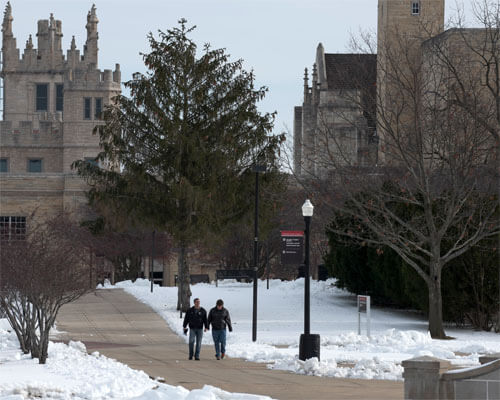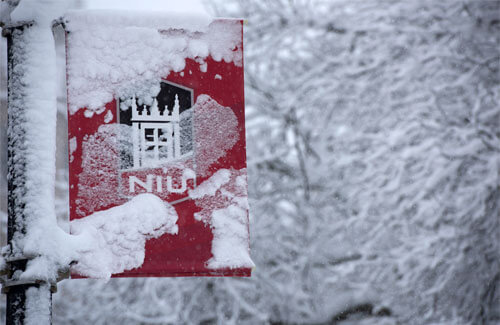 Early morning, Wednesday, Jan. 13. A brisk scroll through the 15-day forecast on a popular smartphone weather app reveals a decent snowstorm pounding northern Illinois, beginning Thursday, Jan. 21, and continuing into Friday, Jan. 22.
Early morning, Wednesday, Jan. 13. A brisk scroll through the 15-day forecast on a popular smartphone weather app reveals a decent snowstorm pounding northern Illinois, beginning Thursday, Jan. 21, and continuing into Friday, Jan. 22.
Snowfall, according to the app, would range from 7 inches to as much as a foot of the white stuff. Not a monster, but probably capable of closing local elementary schools and whipping up a miserable commute.
By the evening of Jan. 13, however, that same app slightly downgraded its numbers on the snow totals.
Twelve hours later, a quick check for an update on those two days revealed – nothing. “Mostly cloudy,” it said. Not one flake expected, no explanation of what had happened and, well, no apology. Nothing to see here, apparently.
White-and-fluffy precipitation soon returned to that forecast, this time only to the tune of 1 or 2 inches, but vanished again as quickly as it had reappeared. Back to “mostly cloudy.”
 Of course, no snow whatsoever fell on those days, at least in this area – maybe it became the system that buried the Eastern Seaboard last weekend – and therefore begs two questions.
Of course, no snow whatsoever fell on those days, at least in this area – maybe it became the system that buried the Eastern Seaboard last weekend – and therefore begs two questions.
Can weather forecasts that go beyond the TV-favored seven days be trusted, especially considering how much they evolve from day to day or even hour to hour? And, if not, why bother to post them at all?
NIU staff meteorologist Gilbert Sebenste pulls no punches.
“To put it bluntly, it’s basically click-bait. It’s just hype and marketing,” Sebenste says.
“For the most part, 15-day forecasts for specific temperatures, weather conditions and precipitation totals have little or no value. Once you get past Day 10, the atmosphere becomes so unpredictable that having a reliable forecast is not going to happen,” he adds.
“People who do these 15-, 30, 45-day forecasts are trying to drive traffic to their websites. A lot of people who work in this industry just shake their heads at these forecasts because they know better.”
Meteorologists making forecasts beyond a week or so should simply report climatological data for the average high and low temperatures, Sebenste says, adding that any level of accuracy achieved so far in advance is “just dumb luck.”
Luck is not required for short-range forecasting, fortunately.
“Short-term weather forecasting – up to seven days – has improved dramatically over the last 20 to 30 years,” says David Changnon, a Board of Trustees Professor and Distinguished Teaching Professor in the NIU Department of Geography.
 How? “Better numerical forecasting models, more and better data integrated into those models and the use of ensemble modeling, where we get all those spaghetti lines showing tracks of storms and hurricanes.”
How? “Better numerical forecasting models, more and better data integrated into those models and the use of ensemble modeling, where we get all those spaghetti lines showing tracks of storms and hurricanes.”
Changnon points to the “monster” snowstorm of Feb. 1, 2011, which dumped nearly 16 inches on DeKalb and closed NIU for three days.
“Sometimes an event five days out is picked up by most models and makes for a great forecast,” says Changnon, who teaches climatology. “When all the different forecasting models begin to approach a weather forecast event similarly, then we weather forecasters have much more confidence in making a ‘confident’ forecast.”
Meteorologists who feel compelled to reach beyond the “confidence” zone should “couch those longer forecasts with an appropriate level of uncertainty,” he adds. “That is the key.”
Although Sebenste agrees that the accuracy of weather forecasting “is a far cry from just 20 years ago,” thanks to advances in technology and modeling, the science is reliant on data.
Data feeding into modern weather balloons and satellites works to perfect three- to 10 day forecasts, he says, and the next generation of satellites will help even more by providing atmospheric data currently unavailable.
 There is always room for error, however, especially if the forecast is complicated. When forecasts “verify” as reliable, he adds, “it’s not so much that they are reliable but that they are within the realm of data that we have.”
There is always room for error, however, especially if the forecast is complicated. When forecasts “verify” as reliable, he adds, “it’s not so much that they are reliable but that they are within the realm of data that we have.”
“You can have all the computer models – the best in the world – but if you do not have data, and good data at that, it does not matter,” Sebenste says.
“We’re good and we’re getting better,” he says. “We still can’t say that we’re going to get 10 inches of snow three days from now, but we can say three or four days out, ‘Hey, there is a decent shot that we may see heavy snow that would require evaluation for a snow closing.’ ”
So what does this say about long-range, seasonal forecasting, a major part of Sebenste’s job description at NIU?
It’s a different science for a different purpose, both say.
Demand for those three-month outlooks compel “some in the weather business to stretch our forecasting capabilities to meet those needs of interests,” Changnon says.
“Certain weather-impacted sectors – energy, agriculture, insurance, etc. – want to have weather forecasting information out as far as someone is willing to give it to them.”
 Last fall’s talk of an El Niño winter, for example, is verifying while prices for natural gas tumble: December 2015 finished 8 degrees higher than average, Sebenste says, and the current bouts of snow and cold aren’t strong enough to counteract that warm first month of winter.
Last fall’s talk of an El Niño winter, for example, is verifying while prices for natural gas tumble: December 2015 finished 8 degrees higher than average, Sebenste says, and the current bouts of snow and cold aren’t strong enough to counteract that warm first month of winter.
“It’s easier to make out a seasonal forecast than it is a 15-day. We smooth out the atmospheric conditions and come up with general trends – ‘Yes, the bias is toward warmer or cooler than average’ – without getting specific,” Sebenste says.
“Is that still usable? Absolutely yes. Energy companies and many utilities will look at those forecasts and say, ‘Aha, we’re going to see a warmer-than-normal summer.’ That means raw utility prices will climb. Companies can then make long-range decisions as to buying electricity or natural gas to avoid price spikes.”

